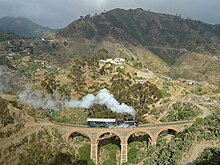Eritrean Railway
| Eritrean Railway | |||
|---|---|---|---|

Eritrean railway, that now connects only Massawa and Asmara, showing a class 440 locomotive at work on the mountainous section between Arbaroba and Asmar
|
|||
| Overview | |||
| Status | Operational | ||
| Locale | Eritrea | ||
| Termini |
Massawa Asmara (originally Bishia) |
||
| Stations | 13 (originally 31) | ||
| Operation | |||
| Opened | Between 1887 and 1932 | ||
| Closed | 1975 | ||
| Reopened | 2003 | ||
| Technical | |||
| Line length | 118 kilometres (73 mi) (originally 337 kilometres (209 mi)) | ||
| Track gauge | 950 mm (3 ft 1 3⁄8 in) | ||
|
|||
The Eritrean Railway is the only railway system in Eritrea. It was constructed between 1887 and 1932 by the Kingdom of Italy for the Italian Eritrea colony and connected the port of Massawa with Bishia near the Sudan border. The line was destroyed by warfare in subsequent decades, but has been rebuilt between Massawa and Asmara. Vintage equipment is still used on the line.
The railway was built by the Italians in order to connect Massawa and Asmara, the main cities of Italian Eritrea.
In the 1930s Italian leader Benito Mussolini wanted to reach Kassala in Sudan, but his war to conquer Ethiopia and create the Italian Empire stopped the enlargement to Agordat and Bishia.
After damage suffered by the railway during World War II, the section between Massawa and Asmara was dismantled partially and was only rebuilt in the 1990s by the Eritrean authorities.
The railway is narrow gauge and is being rebuilt after the devastation wreaked upon it by the war of independence. Its newest equipment is over fifty years old, with most of it predating World War II.
It is one of the few railway systems still in existence (excluding tourist railways) using equipment like the 1930s Italian-built 'Littorina' railcars behind 1930s-vintage Mallet steam locomotives.
Eritrea was an Italian colony, and accordingly its railway was built by Italian engineers to Italian standards, using equipment bought from Italy. The gauge chosen was the Italian standard narrow gauge measurement of 950 mm (3 ft 1 3⁄8 in), similar to many common narrow gauge railways under construction in Italy at the same time.
...
Wikipedia

